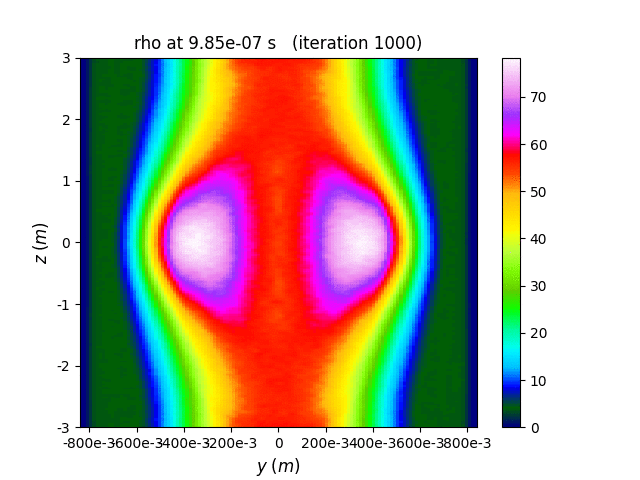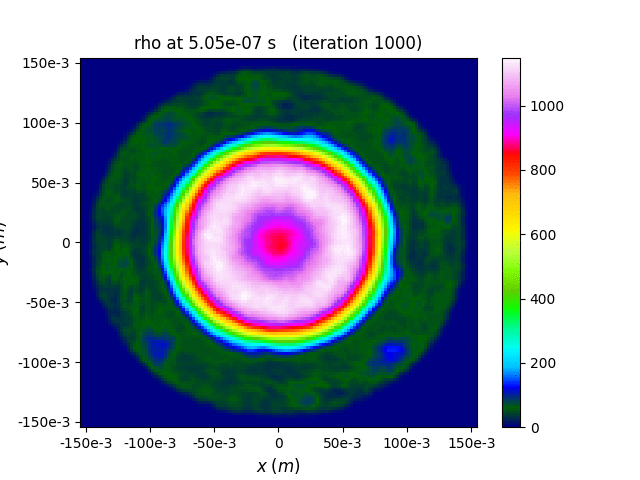A note on FRC instabilities
Dr. David Kirtley, CEO

It’s true, FRCs are unstable.
This is a legitimate concern for physicists working in fusion and plasma research because magnetohydrodynamic (MHD) calculations predict FRCs to be unstable.1 However, more detailed kinetic calculations that take the ion orbits into account, predict stability when certain conditions are met.2 Like spinning a top on your fingertip, rather than a flat surface, it is more likely to wobble and stop spinning. In the same way, an FRC plasma will lose its confinement and rip apart when these conditions go unmet.
Two important instabilities to consider in FRC research are the “tilt mode,”3,4,5 where the FRC wants to flip inside the external magnetic field, and the “rotational mode,”6,7 where the ions inside the plasma spin in such a way that amplifies distortions in its toroidal shape. Both instabilities, predicted by MHD calculations, result in energy losses and an inability for fusion to occur.

In-house simulation of the tilt mode in an FRC

In-house simulation of the rotational mode in an FRC
These instabilities are what led many fusion researchers to abandon the research that eventually led physicists to create FRCs, and instead focus on more traditional fusion approaches like tokamaks or using lasers.
A good question to ask then is, why start a fusion company based on an FRC approach?
FRCs have a really interesting property that makes them desirable for not just making fusion energy, but also getting electricity out of the fusion process – they are high-beta.8 Beta is the ratio of plasma pressure to magnetic pressure; the higher the beta, the “stronger” the pressure is inside the plasma.
A high-beta plasma expands as fusion occurs and is strong enough to push back on the external magnetic field, inducing an increased current – just like regenerative braking in an electric vehicle – back into the magnets powering the fusion process. This direct conversion of fusion energy to electricity greatly simplifies the engineering needs for a fusion power plant. No longer do you need steam turbines and an inefficient heat-to-electricity conversion; instead, you can directly recover electricity straight from the fusion process.
We knew that if we could control the instabilities in FRCs or overcome the instability issues using operational controls, we could leverage the simplicity of the FRC geometry to make more efficient fusion machines, and ultimately, put fusion on the grid faster and cheaper than other fusion methods.
When my team and I started Helion with this ultra-efficient system in mind, we were coming from labs that hadn’t given up on FRC research. We had a knowledge base built upon years of early research including experimental data from LSX9,10,11, an FRC fusion machine at STI Optronics in Bellevue, that demonstrated stability and good confinement.
We knew that if the ion gyro-radius is large enough and the FRC is sufficiently elongated, the FRC is tilt stable.12 This behavior is defined by the kinetic nature of the plasma – the particles moving in the plasma do a better job of confining themselves in longer-shaped FRCs than shorter ones.
However, based on our knowledge, we knew that an elongated FRC would still suffer from rotational instabilities if they weren’t stabilized using external mechanisms or operational controls, like injecting lines of charged particles (neutral beam injection) around the FRC to hold it steady, or pulsing in quick bursts, reducing the time to keep the FRC stable.
We believed that pulsing our machine, reducing the time the FRC has to become unstable, would be an easier engineering challenge to overcome compared to the physics challenge of FRC instabilities. In our case, we are only holding an FRC for less than a millisecond, leaving just enough time for fusion to occur and pull electricity from the reactions, but not enough time for all the particles to get too energized and leave their confinement.

Photos taken of FRCs merging inside Trenta, Helion’s 6th fusion prototype
Experimental data from IPA13, Grande, Venti, and Trenta validate the theory behind our technology and hold up our beliefs that FRCs represent a promising path to commercialize fusion power.
This gives us confidence to continue building.